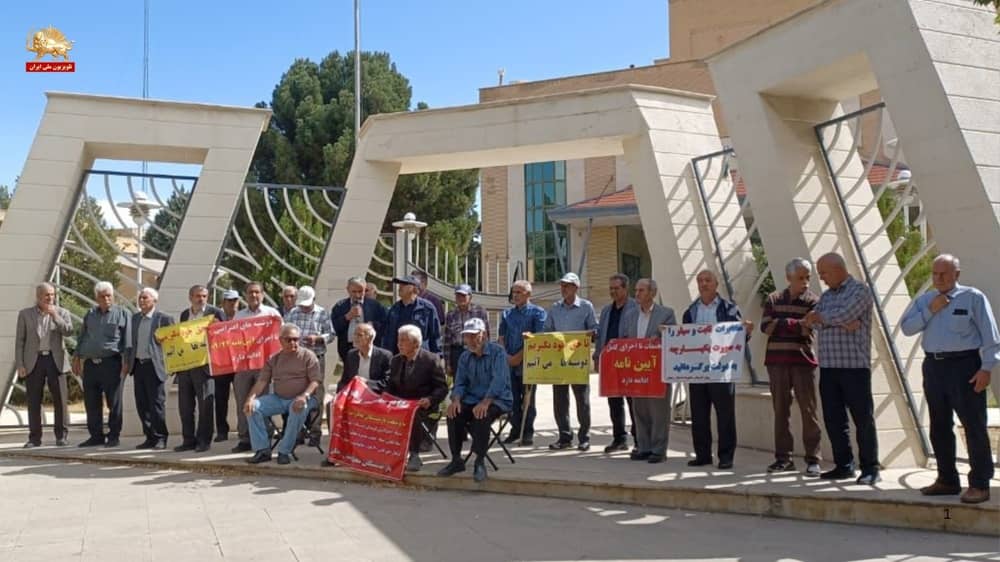
A powerful wave of coordinated protests swept across Iran on Monday, September 22, 2025, revealing a nation seething with anger at the clerical regime’s systemic corruption and economic incompetence. From retired telecommunications workers and steel laborers to doctors and defrauded homeowners, Iranians in dozens of cities took to the streets in a unified display of defiance, directing their fury not just at the government of Masoud Pezeshkian, but at the unaccountable, IRGC-linked institutions at the heart of the state’s repressive apparatus.
The day’s events paint a damning portrait of a society at its breaking point, where years of broken promises and institutional plunder have ignited a nationwide firestorm of discontent.
Retirees’ Uprising Directly Confronts IRGC and Khamenei’s Financial Empire
The most widespread actions of the day were led by retirees of the Telecommunications Company of Iran (TCI), who staged simultaneous protests in several provinces, including Tehran, Khuzestan, Kermanshah, Hamedan, Kurdistan, Fars, and Isfahan. Their unified message was a direct indictment of the regime’s most powerful and corrupt entities.
September 22—Shiraz, southern Iran
Retirees of the Telecommunications Company of Iran (TCI) resume rallies in front of the company's provincial office, protesting low pensions and mismanagement of the company by regime institutions that own the majority of shares.#IranProtests pic.twitter.com/1h0ulAWLVs— People's Mojahedin Organization of Iran (PMOI/MEK) (@Mojahedineng) September 22, 2025
Protesters explicitly named the IRGC Cooperative Foundation (Bonyad Taavon Sepah) and the Execution of Khomeini’s Order (EIKO)—a massive financial conglomerate under the direct control of the Supreme Leader—as the key culprits behind the violation of their rights and the non-payment of their pensions.
In Fars province, the retirees’ chants exposed a complete loss of faith in the regime’s political theater: “Neither parliament, nor the government, cares about the nation!” In the capital, Tehran, their frustration was palpable as they chanted, “We haven’t seen justice, we’ve only heard lies.” The coordinated nature of these protests signals a national movement that has moved beyond simple economic demands to a direct confrontation with the institutional sources of their misery.
September 22—Kermanshah, western Iran
Retirees of the Telecommunications Company of Iran (TCI) rally to highlight their grievances against the company's state-backed shareholders for failing to fulfill financial obligations and pay rightful pensions.#IranProtests pic.twitter.com/9OuC0CjOvh— People's Mojahedin Organization of Iran (PMOI/MEK) (@Mojahedineng) September 22, 2025
Labor in Revolt as Empty Promises Fuel Worker Anger
Simultaneously, Iran’s industrial heartlands were rocked by renewed labor unrest. In Ahvaz, workers from the Iran National Steel Industrial Group once again took to the streets. Their protest resumed after a brief four-day pause, triggered by yet another set of broken promises from company management, provincial authorities, and the state-owned Bank Melli regarding the payment of their long-overdue wages. The workers have vowed to continue their protests until their demands are met.
This pattern of official deception fueling public anger was mirrored in Khuzestan province, where preschool teachers gathered outside the Department of Education to protest unpaid salaries, highlighting the regime’s failure to provide for even its most essential public servants.
September 22—Ahvaz, southwest Iran
Workers of the Iran National Steel Industrial Group in Ahvaz held a protest and marched in objection to the non-payment of their wages and benefits.#IranProtests pic.twitter.com/A5OD8x7Cps— People's Mojahedin Organization of Iran (PMOI/MEK) (@Mojahedineng) September 22, 2025
A Society Fracturing Under Economic Duress
The day’s protests underscored how the regime’s mismanagement has pushed every segment of society to the brink. In the border town of Mirjaveh, dozens of residents protested the continued closure of the Rotak border crossing, which has decimated their primary livelihood—fuel carrying—and left them in dire poverty. One protester lamented that with the start of the school year, families cannot afford basic supplies for their children.
In Parand, a city near Tehran, victims of a state-run housing scheme protested years of delays and broken contracts. A quote from one buyer captured the popular sentiment of state-sponsored fraud: “The national housing project was only to empty people’s pockets, not to house the poor.”
September 22—Mirjaveh, southeast Iran
A group of residents from Mirjaveh County—including the regions of Rig-e Malek, Rutak, and surrounding villages—held a protest in front of the governor’s office to object to the continued closure of the Rutak border crossing and the… pic.twitter.com/t8jaj2jHXC— People's Mojahedin Organization of Iran (PMOI/MEK) (@Mojahedineng) September 22, 2025
The unrest touched all corners of urban life. In Mashhad, taxi van drivers protested the authorities’ ongoing failure to address the crisis in school transportation services, while in Mazandaran province, even family doctors were forced to protest against violations by the regime’s Social Security Organization.
The events of September 22 were not a series of isolated grievances but a synchronized, nationwide rejection of a corrupt and bankrupt system. The Iranian people are no longer just protesting economic hardship; they are identifying and calling out the specific institutions, from the IRGC to Khamenei’s personal financial empire, that are responsible for their suffering.
The slogans and targets of these protests reveal a population that has unequivocally lost all hope in the regime’s capacity for reform. As this popular outrage grows more organized and defiant, it becomes increasingly clear that the Iranian people’s demand is not for minor concessions, but for fundamental change and the reclaiming of their stolen sovereignty.

